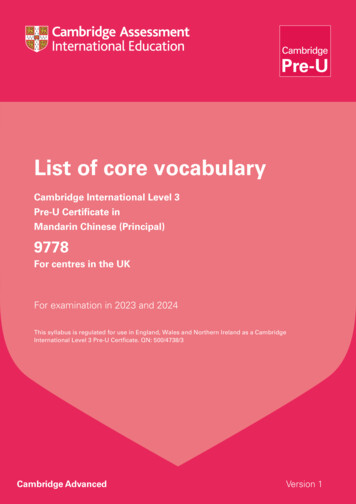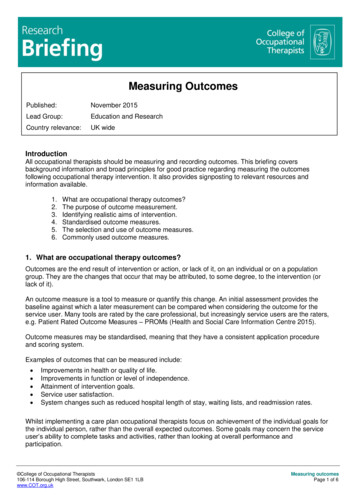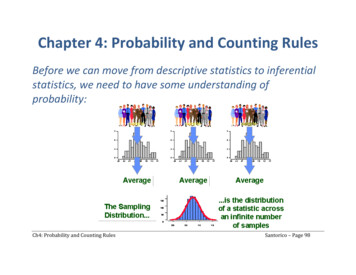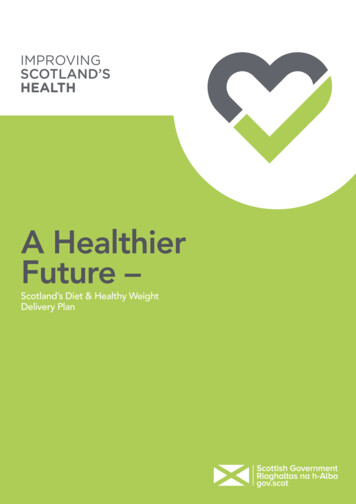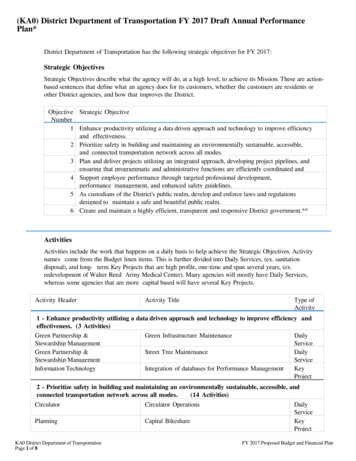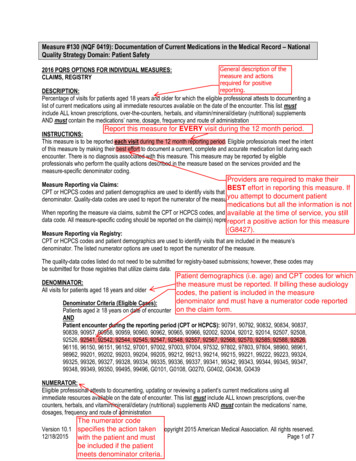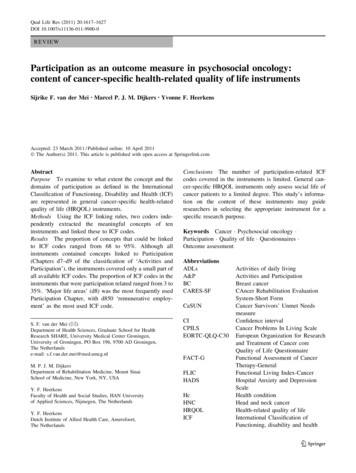
Transcription
Qual Life Res (2011) 20:1617–1627DOI 10.1007/s11136-011-9900-0REVIEWParticipation as an outcome measure in psychosocial oncology:content of cancer-specific health-related quality of life instrumentsSijrike F. van der Mei Marcel P. J. M. Dijkers Yvonne F. HeerkensAccepted: 23 March 2011 / Published online: 10 April 2011Ó The Author(s) 2011. This article is published with open access at Springerlink.comAbstractPurpose To examine to what extent the concept and thedomains of participation as defined in the InternationalClassification of Functioning, Disability and Health (ICF)are represented in general cancer-specific health-relatedquality of life (HRQOL) instruments.Methods Using the ICF linking rules, two coders independently extracted the meaningful concepts of teninstruments and linked these to ICF codes.Results The proportion of concepts that could be linkedto ICF codes ranged from 68 to 95%. Although allinstruments contained concepts linked to Participation(Chapters d7–d9 of the classification of ‘Activities andParticipation’), the instruments covered only a small part ofall available ICF codes. The proportion of ICF codes in theinstruments that were participation related ranged from 3 to35%. ‘Major life areas’ (d8) was the most frequently usedParticipation Chapter, with d850 ‘remunerative employment’ as the most used ICF code.S. F. van der Mei (&)Department of Health Sciences, Graduate School for HealthResearch SHARE, University Medical Center Groningen,University of Groningen, PO Box 196, 9700 AD Groningen,The Netherlandse-mail: s.f.van.der.mei@med.umcg.nlM. P. J. M. DijkersDepartment of Rehabilitation Medicine, Mount SinaiSchool of Medicine, New York, NY, USAY. F. HeerkensFaculty of Health and Social Studies, HAN Universityof Applied Sciences, Nijmegen, The NetherlandsY. F. HeerkensDutch Institute of Allied Health Care, Amersfoort,The NetherlandsConclusions The number of participation-related ICFcodes covered in the instruments is limited. General cancer-specific HRQOL instruments only assess social life ofcancer patients to a limited degree. This study’s information on the content of these instruments may guideresearchers in selecting the appropriate instrument for aspecific research purpose.Keywords Cancer Psychosocial oncology Participation Quality of life Questionnaires Outcome es of daily livingActivities and ParticipationBreast cancerCAncer Rehabilitation EvaluationSystem-Short FormCancer Survivors’ Unmet NeedsmeasureConfidence intervalCancer Problems In Living ScaleEuropean Organization for Researchand Treatment of Cancer coreQuality of Life QuestionnaireFunctional Assessment of CancerTherapy-GeneralFunctional Living Index-CancerHospital Anxiety and DepressionScaleHealth conditionHead and neck cancerHealth-related quality of lifeInternational Classification ofFunctioning, disability and health123
SCLSF-36SLDS-CSPSSWHOQual Life Res (2011) 20:1617–1627Impact Of Cancer version 2Meaningful conceptNot coveredNot definableNot definable-general healthNot definable-mental healthNot definable-physical healthNot definable-quality of lifePersonal factorsQuality of Life in Adult CancerSurvivor scaleQuality Of Life-Cancer SurvivorsinstrumentRotterdam Symptom CheckListShort-Form health surveySatisfaction with Life Domains Scalefor CancerStatistical Package for the SocialSciencesWorld Health OrganizationIntroductionMany studies of cancer patients in past decades havefocused on health-related quality of life (HRQOL), afterthe recognition of HRQOL as an important endpoint incancer clinical research. Measurement instruments usedin these studies generally focused on physical andpsychological well-being, whereas the social dimensionof HRQOL tended to be under-represented [1]. Givenincreased survival rates and the consequent rise in thenumber of patients with a history of cancer, as well as theburden of illness in cancer survivors [2], it seems that thesocial domain of HRQOL should be an area of greaterinterest. Moreover, it would be in line with the definition ofhealth by the World Health Organization (WHO) that statesthat ‘Health is a state of complete physical, mental andsocial well-being and not merely the absence of disease orinfirmity’ [3]. The International Classification of Functioning, Disability and Health (ICF), published by theWHO in 2001 [4], is a much-used framework in the field ofrehabilitation research. The framework of the ICF, as wellas the concept of participation which it introduced, may beuseful in cancer outcome research that aims to assess thesocial health aspect of the WHO’s definition of health.The ICF is a classification of human functioning anddisability and systematically categorizes health and healthrelated states as well as contextual factors that may impactthose states [4]. It is applicable to all persons and not onlyto those with a disability. Disability encompasses the123presence of impairments, activity limitations and participation restrictions, all of which may result from healthconditions (disease, disorder and injury), and are impactedby personal factors as well as environmental factors. Participation, defined as ‘involvement in a life situation’ ([4],p. 10), is differentiated from activity, defined as ‘the execution of a task or action’. The ICF offers a taxonomy forthe domain of ‘Activities and Participation’ (A&P) withnine Chapters that cover an extensive list of basic activitiesof daily living (ADLs), instrumental ADLs, and roles andactivities generally studied as part of community integration, social health or social role participation.Despite the potential value of the biopsychosocialframework of the ICF for the field of oncology research [5–7], to date this framework has been applied on a modestscale, and only a few empirical studies have explicitly usedthe ICF as a frame of reference [8–11]. One use of the ICFinvolved the development of Core Sets of cancer-specificsymptoms and problems in functioning of cancer patients[12–14]. Furthermore, the ICF has served as a tool for theidentification of concepts represented in outcome measures. Brockow et al. [15] analysed outcome measures usedin clinical trials in breast cancer and concluded that functional aspects related to disability and participation werepoorly addressed. Tschiesner et al. [16] examined HRQOLmeasures developed for head and neck cancer and found alarge variation in the use of participation items. Theseresults are in line with older literature that indicates that thesocial domain of HRQOL is under-represented in instruments [1, 17] and that the difficulties cancer patientsexperience in this area have had relatively limited attentionin the field of psychosocial oncology [18].Historically, in the field of oncology, HRQOL instruments have been used to give clinicians and policy makerssystematic information about cancer patients’ capacity oractual performance in important domains of life [19]. In thelight of the WHO’s definition of health, these instrumentsshould adequately reflect all three dimensions of health—physical, mental and social. Therefore, it is important toknow whether participation, a construct that coincides withsocial functioning or social health, which also is an agreedupon key domain of HRQOL [20], is addressed in instruments that are widely used in cancer research.This paper aims to examine to what extent the overallconcept and the specific domains of participation as definedby the ICF are represented in well-known general cancerspecific HRQOL instruments used in psychosocial oncologyresearch. Because of the specific focus on the content ofexisting instruments, a review of the quality (e.g. reliabilityand validity) of the instruments is beyond the scope of thispaper. This paper gives insight as to which domains of participation are addressed by each of the instruments and willassist researchers in the selection of relevant measures.
Qual Life Res (2011) 20:1617–1627MethodsSelection of cancer-specific HRQOL instrumentsHRQOL as an outcome in oncology can be measured usinggeneric instruments, cancer-specific general instrumentsthat can be used with patients with all types of cancers, andcancer site-specific instruments [21]. Our study aimed toinclude general cancer-specific HRQOL instruments, specifically developed for use in oncology research. To identify these instruments, we screened review papers andchapters published in English between 2000 and 2008 thataimed to give an overview of HRQOL instruments developed for adult cancer patients [19, 22–24]. This resulted ina broad range of instruments used in oncology research. Inthe light of the aim of our study, we excluded instrumentsthat were: (1) generic instruments (e.g. SF-36 [25]);(2) cancer site-specific instruments (e.g. modular supplements of the EORTC-QLQ-C30 [26]); (3) domain-specificHRQOL instruments designed to assess one specific aspectof HRQOL (e.g. the Hospital Anxiety and DepressionScale (HADS) [27]); and (4) instruments that did not assessHRQOL but presumably another concept, such as unmetneeds [28, 29].Content identification using the ICF linking rulesThe ICF provides a systematic coding scheme withalphanumeric codes at a maximum of four hierarchicallevels of detail, for instance:‘d7 Interpersonal interactions and relationships’ (firstlevel)‘d750 Informal social relationships’ (second level)‘d7500 Informal relationships with friends’ (third level)To link cancer-specific HRQOL instruments to the ICFcodes, we used a methodology developed by Cieza et al.[30, 31], the ICF linking rules. These rules enableresearchers to systematically link the items of outcomemeasures to the ICF and result in an inventory of conceptsused within instruments. Following these linking rules,each meaningful concept (MC), i.e. unit of text thatconveys a single theme [32] within an instrument item, islinked to the most appropriate corresponding ICF category,identified with its alphanumerical code that indicates thecomponent of the ICF: body functions (b), body structures(s), A&P (d) and environmental factors (e). For example,the item of the Short Form 12 [33] ‘During the past week,how much did pain interfere with your normal work(including both work outside the home and housework)?’has been linked to the ICF categories b280 ‘sensation of1619pain’, d850 ‘remunerative employment’ and d640 ‘doinghousework’ [31]. As the ICF does not offer a taxonomy forpersonal factors, MCs of instrument items that fall withinthis component are only coded with ‘Pf’ [31].In agreement with the linking rules [31], introductorysentences and instructions of the instruments under studywere not linked. Response options of an item were onlylinked if they contained MCs. According to the linkingrules, if MCs are explained by examples, both the conceptand the examples are linked. If a MC does not providesufficient information to make a decision about the mostprecise ICF category, the concept is not definable and isassigned the code ‘Nd’. Not definable MCs that refer tohealth in general or a more specific aspect of health areassigned ‘Nd-gh’ (not definable-general health), ‘Nd-ph’(not definable-physical health) or ‘Nd-mh’ (not definablemental health). MCs that refer to quality of life areassigned ‘Nd-qol’ (not definable-quality of life), and MCsthat refer to a health condition are assigned ‘Hc’ (healthcondition). Furthermore, if MCs are not represented in theICF, they are assigned ‘Nc’ (not covered by ICF).Higher-level Chapter codes were assigned if MCs couldnot be assigned to a category lower in the hierarchy. Code‘b’ (body functions) was assigned to items using nonspecific words such as ‘side effects’, ‘symptoms’ and ‘(changes in) body’. Code ‘d’ (A&P) was assigned to items usingnonspecific terms such as ‘activities’, ‘things you want todo’ and ‘former roles’. Similarly, A&P Chapter codes wereassigned when a more precise second- or third-level codewas not available: ‘need to stay in bed or a chair during theday’ (d4); ‘not being able to care for myself’ (d5); ‘jobsaround the house, activities at home’ (d6); ‘personal relationships’ (d7); and ‘social activities’ (d9). Perceptionswere not coded if they were inextricably bound up withother MCs (e.g. in ‘feeling nervous’ only ‘nervous’ wascoded; in ‘worry about illness’ both worry and illness werecoded).Two coders (SFM and YH) with knowledge of thecontents of the ICF independently extracted MCs from theinstrument items and linked these to ICF codes. Theinstruments were processed one at a time, and after eachmeasure had been completed, the codes assigned werecompared. Disagreement was defined as the identificationof different MCs or the assignment of different ICF codes.Discussion of disagreement resulted in a consensus decision which ICF code to use. The reliability of this procedure was tested for three instruments that were linked in thelast part of the linking procedure. The inter-coder agreement was quantified by calculating kappa with its 95%confidence interval (CI). Calculations were performed withthe statistical software package SPSS, version 16.0 (SPSSInc., Chicago IL., USA).123
1620Qual Life Res (2011) 20:1617–1627Analyses of results of the linking procedureResultsIn presenting the results of the linking procedure, thenumber of identified MCs, including the duplicates (i.e.MCs that are assigned more than once), in a particularinstrument was determined. To examine how many MCs arecontained in one item of the instrument, we computed thecontent density, defined as the ratio of the number of MCsdivided by the number of items in an instrument [34]. Ifeach item contains one MC, then the content density equals1.0; higher values express that more than one MC is foundin the average item of the instrument. The content densityrepresents an aspect of the content validity of instruments;the higher the content density, the more complex the item[35]. To examine the content diversity, we calculated thenumber of different ICF codes (irrespective of the level ofdetail) divided by the number of MCs [34]. The contentdiversity represents the number of MCs corresponding toone and the same ICF code. If each MC is linked to adifferent ICF code, then the content diversity equals 1.0; avalue towards zero expresses that several MCs are linked tothe same ICF code. A lower content diversity may indicate amore differentiated and specific measurement of the topicsthat an instrument aims to explore.Furthermore, we summarized the number of MCs thatcould be linked to ICF codes as well as the MCs that couldnot be linked to ICF codes and accordingly were assigned‘Hc’,’Nd’ and ‘Nc’ codes. To provide insight into theextent to which the components of the ICF are covered bycancer-specific HRQOL instruments, we determined thefrequency distribution of the different ICF categoriesacross the components of body functions, body structures,A&P, environmental factors and personal factors. Withinthe component of A&P, a distinction was made betweenChapters covering Activities (d1 through d6) and Chapterscovering Participation (d7 through d9), as recommended byWhiteneck and Dijkers [36]. This expedient approach waschosen because of the lack of agreement in the literature onhow to distinguish the ICF A&P taxonomy activities fromparticipation [37–39] and the conflicting results of empirical studies on this issue [40–42].For the interpretation of the linking results, we compareour findings with the ICF Core Sets developed for twocancer subgroups (i.e. breast cancer [12]; head and neckcancer [13]). There is no ICF Core Set for cancer in general. ICF Core Sets are a selection of categories out of theentire ICF classification that are relevant for a specificdisease process [43]. A Comprehensive ICF CoreSet allows multidisciplinary assessment of the typicalspectrum of problems in functioning of patients, whereas aBrief ICF Core Set includes only the most important categories [44]. Our results were compared with the Comprehensive and the Brief cancer Core Sets.We identified ten general cancer-specific HRQOLinstruments1231. Functional Living Index-Cancer (FLIC) [45];2. Rotterdam Symptom CheckList (RSCL) [46];3. CAncer Rehabilitation Evaluation System-ShortForm (CARES-SF) [47];4. Satisfaction with Life Domains Scale for Cancer(SLDS-C) [48];5. European Organization for Research and Treatment ofCancer core Quality of Life Questionnaire (EORTCQLQ-C30; version 3) [26];6. Functional Assessment of Cancer Therapy-General(FACT-G; version 4) [49];7. Quality of Life-Cancers Survivors instrument (QOLCS) [50];8. Cancer Problems in Living Scale (CPILS) [51];9. Quality of Life in Adult Cancer Survivor scale(QLACS) [52, 53];10. Impact of Cancer version 2 (IOCv2) [54, 55].Analyses of the reliability of the linking procedure showedgood results. The inter-coder agreement for the SLDS-Cwas 79% (kappa 0.81; 95% CI 0.67–0.96). Inter-coderagreement for the CPILS and QOL-CS was 64 and 76%,and kappa values were 0.65 (95% CI 0.50–0.80) and 0.74(95% CI 0.65–0.84), respectively.Table 1 summarizes the results of the linking procedure.The number of items in the instruments ranged from 18 to59, and the total number of identified MCs ranged from 23to 150. With a high number of MCs per item, the IOCv2has the highest content density ratio (3.2), while the RSCLhas the lowest content density ratio (1.1) with 42 MCsassigned to 39 instrument items.The proportion of MCs that could be linked to ICF codesranged from 68% (IOCv2) to 95% (RSCL). MCs that wereclassified as ‘not definable’ mostly received the designationof ‘general health’. The IOCv2 had the highest number ofMCs that were linked to ‘health condition’ (n 32). Thisscale often uses ‘cancer’ in its items (e.g. ‘Having hadcancer has made me feel alone’). MCs classified as ‘notcovered’ (Nc) addressed items such as ‘dying’, ‘future’,‘time in life is running out’, ‘direction in life’ and ‘positivechanges in life’. The number of different ICF codes assignedto the instruments ranged from 17 to 50. With respect tocontent diversity, the QOL-CS had the lowest ratio (0.30);79 MCs were linked to 24 different ICF codes. The SLDS-Cand RSCL both had a content diversity ratio of 0.74.Table 2 shows the distribution of MCs in each of the teninstruments over the five major ICF components. Allinstruments contained concepts linked to A&P. With the
1.727 (73%)5Content density(MCs per item)MCs linked to ICFcomponents (n, %)MCs linked to healthcondition (n)180.49Different ICF codes (n)Content diversity(ICF codes per MC)0.74311140 (95%)1.14239RSCL0.44509104 (92%)1.911359*CARES-SF0.741712119 (83%)1.32318SLDS-C0.683213142 (89%)1.64730EORTCQLQ-C300.50191112132 (84%)1.43827FACT-GContent diversity the number of different ICF codes used divided by the number of MCsDifferent ICF codes number of different ICF codes assigned to the MCsContent density the number of MCs divided by the number of the instrument’s itemsMCs number of meaningful concepts assigned to the items in the instruments (duplicates included)* Items that were not applicable if a certain condition was met (e.g. not having a partner) were included1MCs not covered (n)Quality of lifePhysical healthGeneral health437MCs (n)MCs not definable (n)22Scale items (n)FLIC0.30244211557 (72%)1.97941QOL-CSTable 1 The number of meaningful concepts and the number of different ICF codes identified in ten HRQOL instruments0.502012334 (85%)1.44029CPILS0.3126211468 (80%)1.88547QLACS0.324871832102 (68%)3.215047*IOCv20.4428518861879525 (80%)1.8654359TotalQual Life Res (2011) 20:1617–16271621123
1622Qual Life Res (2011) 20:1617–1627Table 2 Representation of the ICF components in ten HRQOL instrumentsFLICDifferent ICF codes %50%46%35%2%6%ICF components*bBody functionssBody structuresdActivities and %ParticipationEnvironmental 7%12%29%17%pfPersonal factors5%4%5%4%2%6%2%* Column entries show the percentage of different ICF codes in each instrument that is linked to the ICF component listedDue to rounding, the sum of percentages can be less than or greater than 100%exception of the RSCL, all instruments addressed ‘environmental factors’ (range 3–26%) and MCs classified as‘personal factors’ were present in 7 scales (range 2–6%). Asubstantial part of the MCs in each instrument is linked tothe component ‘body functions’.The proportion of participation-related ICF codes ranged from 3 to 35%. The SLDS-C has the highest proportionof such codes followed by the IOCv2. For four out of 10instruments, less than 20% of MCs were linked to participation-related ICF codes. In the RSCL, only 3% of theinstrument’s MCs could be linked to participation.Table 3 presents the distribution of MCs over the nineChapters of A&P. With respect to Participation, six of theinstruments address all three Participation Chapters. Threeinstruments (i.e. FLIC, CARES-SF and CPILS) onlyaddress 2 Chapters, and the RSCL only 1. The FLIC andRSCL do not contain MCs related to ‘Interpersonal interactions and relationships’ (Chapter 7). Similarly, ‘Community, social and civic life’ (Chapter 9) is not covered bythe RSCL, CARES-SF and CPILS. Chapter d8 ‘Major lifeareas’ is the most used Participation Chapter and is coveredby all instruments. With respect to all nine A&P Chapters,Table 3 Representation of the ICF Chapters ‘Activities and Participation’ in ten HRQOL instrumentsICF codesFLIC RSCL CARES-SF SLDS-C EORTC- FACT-G QOL-CS CPILS QLACS IOCv2QLQ-C30Activities*d1 Learning and applyingknowledge176%18%6%d2 General tasksand demands540%20%20%d3 Communication12d4 Mobility1513%20%8725%29%63%29%13%14%50%13%38%13%d5 Self-cared6 Domestic Participation*d7 Interpersonal interactionsand relationshipsd8 Major life areasd9 Community, social,and civic 1%33%17%Total number of first- and second-level ICF codes within each of the ICF A&P Chapters listed; ‘other specified’ and ‘unspecified’ codesexcluded* Per cent of the ICF codes that is represented in the instrument, calculated per A&P Chapter (number of first- and second-level ICF codesidentified in the instrument divided by the total number of first- and second-level ICF codes in the corresponding A&P Chapter; ‘other specified’and ‘unspecified’ codes excluded)123
Qual Life Res (2011) 20:1617–16271623Table 4 ICF Chapters addressing Participation represented in ten HRQOL instruments, presented at the detail of the second-level of the ICFICFFLICcodes*d7Interpersonalinteractionsand relationshipsRSCL CARESSFSLDS- EORTCCQLQC30FACT- QOL- CPILS QLACS IOCv2 ICF CoreGCSSetsHNC BC7d710 Basic interpersonalinteractions?d720 Complexinterpersonalinteractionsd750 Informal socialrelationships?d760 Family relationships?d770 Intimate relationshipsd8Major life areas? [?] jj?jj[?]jh jh? [?] j?d850 Remunerativeemployment?d870 Economic selfsufficiencyCommunity, socialand civic life?jjh? [?]?jh?5jd910 Community lifed920 Recreation andleisurejh12d845 Acquiring, keepingand terminatinga jobd9?j?d930 Religion andspirituality?[?]?jjhj* Total number of second-level ICF codes in each Participation Chapter (‘other specified’ and ‘unspecified’ codes excluded)ICF codes not covered in the instruments or in the ICF Core Sets are omitted from this table? indicates that the ICF code is represented in the instrument[?] indicates that the ICF code is represented in the instrument as an examplej indicates that the ICF code is represented in the Comprehensive ICF Core Sets for head and neck cancer (HNC) or breast cancer (BC)h indicates that the ICF code is represented in the Brief ICF Core Sets for HNC or BCthe EORTC-QLQ-C30 and the IOCv2 cover the most(7 out of 9), whereas the CPILS covers only 3 Chapters.Table 4 presents the second-level ICF codes of theParticipation Chapters (Chapters 7–9) that were identifiedin the instruments. Certain ICF participation codes werenot covered at all (omitted from the table): d730 ‘relatingwith strangers’, d740 ‘formal relationships’ (e.g. relationship with employer), d810 through d830 ‘education’, d840‘apprenticeship (work preparation)’, d855 ‘non-remunerative employment’, d860 ‘basic economic transactions’,b865 ‘complex economic transactions’, d910 ‘communitylife’ (e.g. engagement in social clubs and associations),d940 ‘human rights’ and d950 ‘political life and citizenship’. Although the SLDS-C and IOCv2 contain the MC‘school’, due to the lack of specificity on the type ofeducation this concept was linked to the code d8 (‘Majorlife areas’) and not more specifically to one of the thirdlevel education codes.The most frequently used ICF code is d850 ‘remunerative employment’; only the CPILS and the QLACS do nothave MCs corresponding to this code (Table 4). Otherfrequently used ICF codes were d770 ‘intimate relationships’ and d920 ‘recreation and leisure’, both covered in60% of the instruments. d760 ‘family relationships’ andd870 ‘economic self-sufficiency’ were covered in half ofthe instruments. A minority of the scales included ‘complex interpersonal interactions’ (d720) and ‘informal socialrelationships’ (d750), as well as ‘acquiring, keeping andterminating a job’ (d845). The ICF category ‘religion andspirituality’ (d930) was covered by just one scale.123
1624The section ‘work and employment’ (d840–d859) ofChapter 8 ‘Major life areas’ contains the most frequentlyused ICF code d850 (‘remunerative employment’). TheMCs linked to this code differ in the wording used such asemployment (QOL-CS), job (SLDS-C), go to work(RSCL), ability to work (CARES-SF) and not being able towork (IOCv2). In addition, the aspect of interest related towork that is asked about differs between instruments (e.g.ability, limitation, satisfaction and fulfilment).Comparison of assigned participation-related ICF codeswith the ICF Core Sets (Table 4) showed that none of theHRQOL instruments covers the entire Comprehensive ICFCore Set for head and neck cancer (HNC), whereas thecomprehensive set for breast cancer (BC) is only coveredby the IOCv2. The Brief Core Set for HNC is covered bythe EORTC-QLQ-C30 and the CPILS. The Brief Core Setfor BC is covered by the SLDS-C, FACT-G and IOCv2.DiscussionThis study provides an overview of the content of generalcancer-specific HRQOL instruments. Content identificationwas performed by linking meaningful concepts in instrument items to the ICF domains by applying the ICF linkingrules. All ten instruments selected contain concepts thatrepresent participation as defined by the ICF (Chapters d7through d9 of the classification of Activities and Participation). However, the number of ICF participation codescovered in the instruments is limited. Aside from the totalabsence of some ICF codes across the ten scales, eachinstrument only contains a small part of all available ICFcodes. With regard to interpersonal interactions and relationships (Chapter 7), the scales mainly assess intimate andfamily relationships, whereas formal and informal socialrelationships are minimally included. Work or employmentis covered by all scales, but other areas listed in Chapter 8,such as getting an education, are under-represented. Nonremunerative employment (volunteering) is not covered byany of the instruments. The least adequately covered isChapter 9 ‘Community, social and civic life’ with areassuch as engagement in social life outside the family, participation in religion and spirituality, human rights, political life and citizenship. These results indicate that theavailable general cancer-specific HRQOL instruments donot comprehensively assess participation in society bycancer patients.Besides differences between measures in the domains ofparticipation covered, the linkage procedure also showeddifferences in how many concepts and ICF codes areincluded per average item. There is variation in the numberof MCs per item (content density), in the percentage of theMCs that could be linked to the ICF and in the diversity of123Qual Life Res (2011) 20:1617–1627the ICF codes covered. From a measurement methodologypoint of view, it is desirable that items are clearly statedwith a minimum number of MCs. A high content densityscore indicates more complex items (more MCs per item).Patients may have difficulty understanding and answeringthese items. One may question how responses of patients tothese ‘dense’ items should be interpreted. A low contentdiversity score indicates that several MCs relate to thesame ICF code and may indicate redundancy of items.However, a low content diversity also facilitates a moredifferentiated and specific measurement. Content densityand diversity may be helpful in comparing instruments andare useful indicators of the ICF-based contents of instruments [35].The results show that participation is covered to a limited extent in well-known general cancer-specific HRQOLinstruments. Whether this should be considered as aproblem depends on the purpose of the researcher who usesthese instruments. If the aim of a study is to present anoverview of the effects of cancer or its treatment onpatients’ functioning, then some of the instruments arerather comprehensive. The EORTC-QLQ-C30 and IOCv2,for example, both cover seven of the nine A&P Chaptersand assess body functions as well. However, if the limitedset of items in these instruments is used to draw firmconclusions regarding, for example, the social domain ofHRQOL, there may be a problem because the extent towhich the items are representative of a cancer patients’entire social life is limited.It is debatable whether all ICF codes related to participation should be incorporated in new instruments that aimto comprehensively capture participation in
The proportion of ICF codes in the instruments that were participation related ranged from 3 to 35%. 'Major life areas' (d8) was the most frequently used Participation Chapter, with d850 'remunerative employ-ment' as the most used ICF code. Conclusions The number of participation-related ICF codes covered in the instruments is limited.
